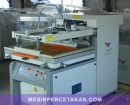Fine art inkjet printing
Fine art digital printing evolved from digital proofing technology in
the printing industry. As the printing industry became digital,
traditional film-based proofing became cumbersome and cost prohibitive.
Kodak,
3M, and other major manufacturers developed large format inkjet printers using dye based inks or archival,
lightfast
pigment based inks. Initially, these printers were limited to glossy
papers, but the IRIS Graphics printer allowed the use of a variety of
papers that included traditional and non-traditional media.
Graham Nash,
of Crosby, Stills, Nash and Young, was one of the early pioneers of
experimental digital printmaking, and he began using the new proofing
technology from IRIS Graphics to print his own photographs and digitally
manipulated images. Nash and his associate Mac Holbert opened
Nash Editions in 1991 and adapted an IRIS printer to meet the needs of artists.
Challenges in fine art printmaking include the need for exceptionally
accurate high-resolution scanning and/or photographing of original
artwork, managing large file sizes, viewing and interpreting image files
onscreen, and artist-printmaker communication. Key software and
computer providers have been Adobe Photoshop and Apple Computer, along
with
Silicon Graphics,
who were on the forefront of color image management for both graphic
arts and fine art printmaking. Longevity is always an important
consideration in fine art, whether in reproductions (such as serigraphs
or lithographs) or in an original work. It is a well-accepted fact that
paintings, especially watercolors, must be protected from the elements,
therefore the lightfastness of digital inks was a critical issue. The
original proofing inks were not archival, but printmakers experimented
with coatings and substrates to achieve greater longevity. A
collaborative effort by artists, including the group known as
Unique Editions, worked with printmakers to produce archival quality on a variety of substrates. The
IRIS printer
was the standard for fine art digital printmaking for many years, and
is still in use today, but as the field grew, printmakers, and printer
manufacturers began to offer alternative equipment for printmaking. More
powerful computers, improved software, and viewing technologies have
expanded possibilities for artists and printmakers.
Substrates in giclée printmaking include traditional fine art papers such as Rives BFK, Arches
watercolor paper,
treated and untreated canvas, experimental substrates (such as metal
and plastic), and fabric. This has allowed for the creation of limited
and unlimited reproductions of artworks.
[4]
Depending on the printing inks and substrate, longevity of the digital
print may be limited. Although the color range of the digital process
cannot always match an original pigment, artists and fine art digital
printmakers can work together for exceptional quality with
repeatability. Digital printing also allows for the output of
digital art
of all types as finished pieces or as an element in a further art
piece. Experimental artists often add texture or other media to the
surface of the final prints, or use them as part of a mixed-media work.
Many terms for the process have been used over the years, including
digigraph, but fine art digital printmaking is generally known as
giclée, and, although there are still a few exceptions, giclées are
widely accepted as a fine art medium by museums and galleries. Thousands
of digital printmakers now offer services to painters, photographers,
and digital artists around the world.
Digital laser exposure onto traditional photographic paper
Digital images are exposed onto true, light sensitive
photographic paper with lasers and processed in photographic developers and fixers. These prints are true photographs and have
continuous tone
in the image detail. The archival quality of the print is as high as
the manufacturer's rating for any given photo paper used. In large
format prints, the greatest advantage is that, since no lens is used,
there is no vignetting or detail distortion in the corners of the image.
Digital printing technology has grown significantly over the past few
years with substantial developments in quality and sheet sizes.
http://en.wikipedia.org/wiki/Digital_printing#Digital_printing_methods_of_note








